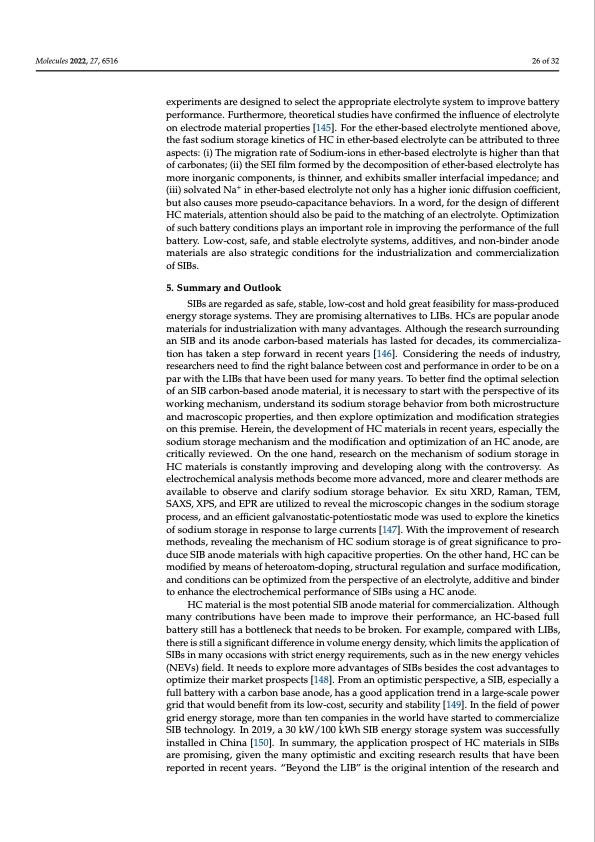
PDF Publication Title:
Text from PDF Page: 026
Molecules 2022, 27, 6516 26 of 32 experiments are designed to select the appropriate electrolyte system to improve battery performance. Furthermore, theoretical studies have confirmed the influence of electrolyte on electrode material properties [145]. For the ether-based electrolyte mentioned above, the fast sodium storage kinetics of HC in ether-based electrolyte can be attributed to three aspects: (i) The migration rate of Sodium-ions in ether-based electrolyte is higher than that of carbonates; (ii) the SEI film formed by the decomposition of ether-based electrolyte has more inorganic components, is thinner, and exhibits smaller interfacial impedance; and (iii) solvated Na+ in ether-based electrolyte not only has a higher ionic diffusion coefficient, but also causes more pseudo-capacitance behaviors. In a word, for the design of different HC materials, attention should also be paid to the matching of an electrolyte. Optimization of such battery conditions plays an important role in improving the performance of the full battery. Low-cost, safe, and stable electrolyte systems, additives, and non-binder anode materials are also strategic conditions for the industrialization and commercialization of SIBs. 5. Summary and Outlook SIBs are regarded as safe, stable, low-cost and hold great feasibility for mass-produced energy storage systems. They are promising alternatives to LIBs. HCs are popular anode materials for industrialization with many advantages. Although the research surrounding an SIB and its anode carbon-based materials has lasted for decades, its commercializa- tion has taken a step forward in recent years [146]. Considering the needs of industry, researchers need to find the right balance between cost and performance in order to be on a par with the LIBs that have been used for many years. To better find the optimal selection of an SIB carbon-based anode material, it is necessary to start with the perspective of its working mechanism, understand its sodium storage behavior from both microstructure and macroscopic properties, and then explore optimization and modification strategies on this premise. Herein, the development of HC materials in recent years, especially the sodium storage mechanism and the modification and optimization of an HC anode, are critically reviewed. On the one hand, research on the mechanism of sodium storage in HC materials is constantly improving and developing along with the controversy. As electrochemical analysis methods become more advanced, more and clearer methods are available to observe and clarify sodium storage behavior. Ex situ XRD, Raman, TEM, SAXS, XPS, and EPR are utilized to reveal the microscopic changes in the sodium storage process, and an efficient galvanostatic-potentiostatic mode was used to explore the kinetics of sodium storage in response to large currents [147]. With the improvement of research methods, revealing the mechanism of HC sodium storage is of great significance to pro- duce SIB anode materials with high capacitive properties. On the other hand, HC can be modified by means of heteroatom-doping, structural regulation and surface modification, and conditions can be optimized from the perspective of an electrolyte, additive and binder to enhance the electrochemical performance of SIBs using a HC anode. HC material is the most potential SIB anode material for commercialization. Although many contributions have been made to improve their performance, an HC-based full battery still has a bottleneck that needs to be broken. For example, compared with LIBs, there is still a significant difference in volume energy density, which limits the application of SIBs in many occasions with strict energy requirements, such as in the new energy vehicles (NEVs) field. It needs to explore more advantages of SIBs besides the cost advantages to optimize their market prospects [148]. From an optimistic perspective, a SIB, especially a full battery with a carbon base anode, has a good application trend in a large-scale power grid that would benefit from its low-cost, security and stability [149]. In the field of power grid energy storage, more than ten companies in the world have started to commercialize SIB technology. In 2019, a 30 kW/100 kWh SIB energy storage system was successfully installed in China [150]. In summary, the application prospect of HC materials in SIBs are promising, given the many optimistic and exciting research results that have been reported in recent years. “Beyond the LIB” is the original intention of the research andPDF Image | Hard Carbons as Anodes in Sodium-Ion Batteries

PDF Search Title:
Hard Carbons as Anodes in Sodium-Ion BatteriesOriginal File Name Searched:
molecules-27-06516-v2.pdfDIY PDF Search: Google It | Yahoo | Bing
Salgenx Redox Flow Battery Technology: Salt water flow battery technology with low cost and great energy density that can be used for power storage and thermal storage. Let us de-risk your production using our license. Our aqueous flow battery is less cost than Tesla Megapack and available faster. Redox flow battery. No membrane needed like with Vanadium, or Bromine. Salgenx flow battery
| CONTACT TEL: 608-238-6001 Email: greg@salgenx.com | RSS | AMP |